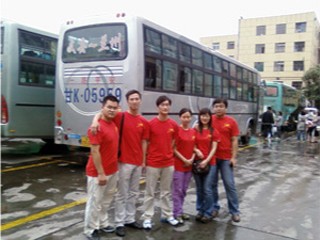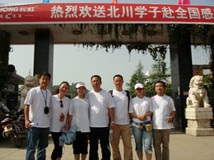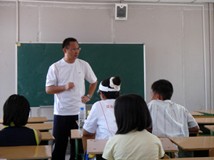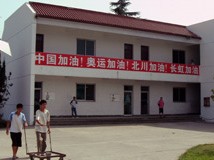In view of the gravity of the situation, the Tokyo Foundation called out to our scholarship recipients (called SYLFF fellows) in China for proposals concerning aid activities. Two volunteer activities were selected and given financial support. The author flew to China to observe the operations.
* * *
On May 12, 2008, an extremely strong earthquake struck China, centering on Wenchuan County, Sichuan Province. News of this major disaster and the extensive damage it wrought-over 80,000 people confirmed dead or listed as missing, and more than 370,000 people injured-were widely reported throughout the world, including Japan. The Tokyo Foundation has been providing scholarships to graduate students in 10 universities in China through the Ryoichi Sasakawa Young Leaders Fellowship Fund (SYLFF) since 1992, with the aim of nurturing leaders in various fields. In view of the gravity of the situation, the Foundation called out to the scholarship recipients in China for proposals concerning aid activities for the victims. Twelve proposals were submitted, and among them, the Tokyo Foundation selected two volunteer activities led by SYLFF fellows at Lanzhou University and Chongqing University. These groups were given financial support by the Foundation, and activities were conducted in August. I flew to China to observe the operations of these two groups, and the following is my report from the field.

All-Out Efforts in Red T-Shirts Following a 20-Hour Bus Ride
-SYLFF fellows team from Lanzhou University-
Tuesday, August 19. Flying from Narita via Beijing, which was teeming with excitement over the Olympics, I arrived in Lanzhou City in Gansu Province. It was a rather chilly day for the height of summer, with a light drizzle of rain. I was greeted by the welcoming smile of Zeng Xianghong, a SYLFF fellow from Lanzhou University, clad in a bright red T-shirt. Mr. Zeng was the leader of this project. The T-shirt he wore carried the words "heart-to-heart" in Chinese characters on its left breast, and boldly emblazoned on the back was the Chinese for "The Tokyo Foundation-Lanzhou University Aid Activities for Prospective College Students in Wenxian." The team apparently made these shirts for their activity. "Given that we have received support from the Foundation, we will work firmly to aid our countrymen," said Mr. Zeng.
The Lanzhou University SYLFF fellows were to depart on the 20th, the following day, for the Wenxian District roughly 360 kilometers to the south. Their mission was to go to a local high school where, to about 180 students scheduled to enter universities, they would distribute school supplies and items for daily living needed at the start of school, and provide guidance on university life as well. I was also planning to accompany them there.
But then, the unexpected happened. After my arrival at Lanzhou, we learned that the authorities were not allowing foreigners to visit regions like Wenxian, which had suffered great damage from the earthquake. I had inquired about this to the fellows before my departure from Tokyo, but was told that there would be no problem. Lanzhou University contacted the Gansu provincial authorities to reconfirm, but the government was adamant that this "will not be permitted." Sichuan had experienced several powerful aftershocks that had claimed more victims. And because this visit coincided with the Beijing Olympics, the university officials and fellows believed that the authorities were being overly sensitive about the situation in order to make sure that no accidents or incidents involving foreigners occurred.

I reluctantly abandoned my plans to accompany the group. Waving to me as I saw them off, the SYLFF fellows got onto a long-distance bus equipped with sleeping berths, scheduled to depart at 5 p.m. for Wenxian. This was the start of a long journey that would take nearly 20 hours-providing that everything went smoothly. The compartment of the bus was made up entirely of bunk beds. In addition to these double-decker beds lining both sides of the bus, a single line of bunks ran down the center of the bus as well. The aisles were just barely wide enough for a person to pass through by walking sideways, and the beds were so narrow that rolling over in your sleep would be no easy task. Nonetheless, "I took this bus there the other day for a pre-inspection of the site and it was fine," said Mr. Zeng. I learned that six of the Lanzhou University fellows were able to purchase tickets for this direct bus to Wenxian. The remaining two men on the team, who were unable to get hold of tickets, had left the day before and were already on their way via another route.
To avoid any secondary disasters, after discussion with the principal of the high school in Wenxian, it was decided to shorten the original agenda for the program and conduct concentrated activities on just one day. In response to our e-mail from Tokyo, Mr. Zeng later said, "Although the support we provided to the high school students of Wenxian was extremely limited, we were able to do our best for those affected by the disaster."
Counseling to Heal the Hearts of Children
-SYLFF fellows team from Chongqing University-
Thursday, August 21. I flew from Lanzhou to Chengdu, the capital of Sichuan Province, to meet up with Tang Songlin, a SYLFF fellow from Chongqing University and the leader of the project there. His team was to give psychological counseling to middle school students in Mianyang about two hours away from Chengdu by express bus. In many cases, large disasters not only result in physical damage, but also leave the victims with deep psychological scars known as PTSD, or post-traumatic stress disorder. This tendency is particularly noted in adolescents. On the 22nd, the following day, Mr. Tang led me onto a bus to observe the activities his team was undertaking at Beichuan Middle School near Mianyang.
Many readers may recall seeing news reports about Beichuan Middle School. Footage showed students enjoying a school activity on the day before the earthquake and the tragic sight of the school building with its lower levels crushed by the strong tremors of the earthquake. The actual site of this disaster was in the mountains about 50 kilometers from Mianyang; the Beichuan Middle School I visited was the school after its relocation. (Unaware of this fact, I embarrassed myself by asking questions like, "Where is the crushed schoolhouse?")

The school had moved to its current location in the Shengshui District in the suburbs of Mianyang. One of China's leading electronics manufacturers, Changhong, which has its headquarters in Mianyang, offered Beichuan Middle School the use of its grounds and training center facilities. Classes are now held there, and the students are living in dormitories on the grounds. Because existing facilities alone were definitely not enough to accommodate them, temporary classrooms and dormitories were built through donations from outside.
The team members totaled seven, including Mr. Tang. Aside from Mr. Tang, the members were not SYLFF fellows, but they were all either working in Chongqing or studying or teaching at Southwest University or other local universities and had responded to Mr. Tang's call for support.
This program aimed to hold group-counseling sessions with heart-to-heart communication for middle school students with PTSD. Although this was only a one-day activity, counseling was given to 14 third-year students of Beichuan Middle School (10 boys and 4 girls).
One of the members of the team, He Guolian, was the main figure in the counseling session. Mr. He usually holds seminars for business people, but is also very experienced in counseling.

Mr. He and the other members of the team spoke gently to each of the students gathered in the classroom in an endeavor to relate to them. There were children who burst into tears remembering their teacher who died trying to rescue the students during the quake; others had their heads bowed down, refusing to remember that the earthquake even occurred. I was struck by the depths of the mental scars left on these children after experiencing such a colossal disaster. I was also very impressed that Mr. He didn't try to stop them from crying, nor ever try to deny their statements, but strived to help them face their feelings. Several members of the team who were students majoring in psychology and had counseling experience in disaster-stricken areas did a wonderful job assisting Mr. He.
Near the end of the session, Mr. He asked the students what their dreams for the future were. With this question, the downcast expressions on these students' faces brightened a bit as they spoke with sincerity about what they want to be in the future: "I want to be a doctor," "I want to be an NBA basketball player like Yao Ming," "I want to be an engineer," "A pilot," "A singer," "An actress"... (I wonder if middle school students in Japan can speak so radiantly about their dreams.) I sincerely wish them much happiness in the future.
From the day following the end of activities at Beichuan Middle School, the team was scheduled to conduct similar counseling sessions for about one week at a school in the township of Leigu in Beichuan County. "Remote areas receive little attention and little relief. This makes our activities even more necessary," said one member, Chen Yan. While the base for their operations will, in principle, be located in Mianyang, they told me that depending upon the circumstances, they might be staying in Leigu to carry out their activities.
I was again unable to accompany the team because this area was also off-limits to foreigners. The opportunity I had to observe their activities at Beichuan Middle School, however, was enough for me to fully appreciate the enthusiasm and strong commitment of the team members.
News reports in Japan about the Great Sichuan Earthquake are becoming less frequent. But the physical damage inflicted on the victims and their psychological trauma will not be so easily healed. By introducing these activities undertaken by SYLFF fellows, I hope that interest will be aroused and that this will serve as encouragement to other SYLFF fellows.

The purpose of SYLFF is to raise the leaders of tomorrow who will be active in a broad range of fields in regions throughout the world. The exhibition of their will to contribute to the needs of society, such as was shown here, is of enormous joy to those of us who are in charge of the SYLFF Program, and we are happy to have been able to give some support for their activities. This time's support was an experimental case, but we hope that the SYLFF Program will continue to be one that can respond flexibly to the enthusiasm and initiatives of SYLFF fellows as they work to address the various problems facing humanity.
